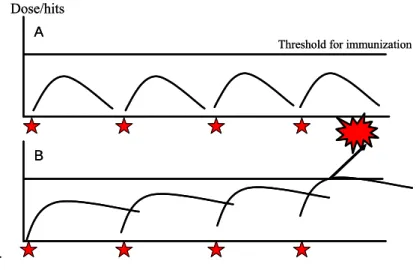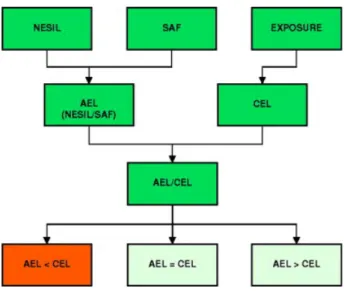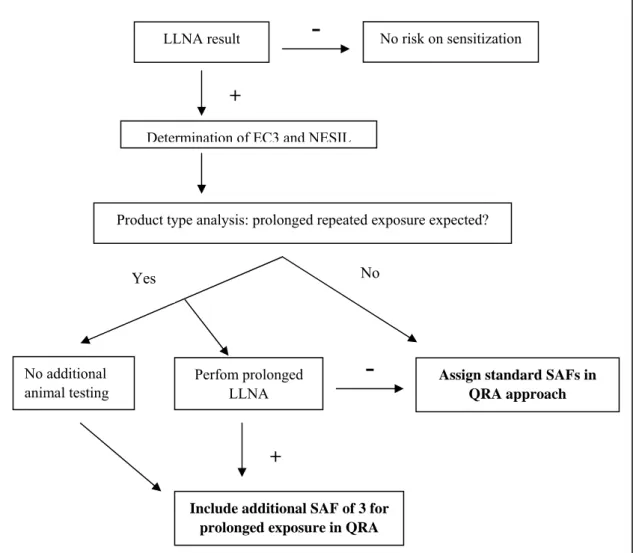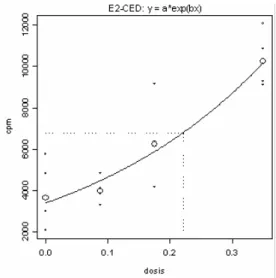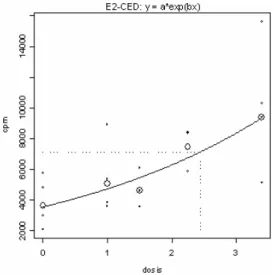Letter report 340300005/2010
J. Ezendam | J. Vermeulen | H. van Loveren
Effects of prolonged exposure to skin
sensitizers in concentrations below
the EC3 value
RIVM, P.O. Box 1, 3720 BA Bilthoven, the Netherlands Tel +31 30 274 91 11 www.rivm.nl
RIVM Letter report 340300005/2010
Effects of prolonged exposure to skin sensitizers in
concentrations below the EC3 value
Implications for quantitative risk assessment
J.Ezendam J.Vermeulen H. van Loveren
Contact: J.Ezendam
Laboratory for Health Protection Research janine.ezendam@rivm.nl
This investigation has been performed by order and for the account of Ministry of Health, Welfare and Sports and the Food and Consumer Product Safety Authority, within the framework of V/340300 Advisering en kennisbasis sensibilisatie
© RIVM 2010
Parts of this publication may be reproduced, provided acknowledgement is given to the 'National Institute for Public Health and the Environment', along with the title and year of publication.
RIVM Letter Report 340300005 3
Contents
Summary 4
1 Background 6
2 Quantitative risk assessment approach 8
2.1 Overview of currently proposed QRA approach 8 2.2 Incorporation of the a safety factor prolonged exposure in the QRA approach 9 2.3 Illustration of the applicability of the decision tree 10
References 12
Appendix 1: Experimental design and analysis of the prolonged LLNA 14 Appendix 2: Results of the prolonged LLNA 17
Summary
For skin sensitization a quantitative risk assessment (QRA) has been proposed that can be used to estimate safe levels of exposure for specific products. This approach uses EC3 data from the mouse Local Lymph Node Assay (LLNA) as a point-of-departure. Exposure in the LLNA is short, whereas in real-life people are exposed often daily to all kinds of products. Previously, by using a prolonged protocol of the LLNA, it was shown that some skin sensitizers are able to induce immune activation at concentrations below the EC3 value. For these specific substances the EC3 value is not an appropriate starting point in the QRA approach when safe exposure levels need to be found for products that are used frequently. For these specific products the QRA approach should be modified. In this letter report a decision scheme is presented that includes prolonged exposure as a uncertainty factor in the QRA approach. The decision scheme was applied to assess effects of prolonged exposure to two hair dye ingredients: para-phenylenediamine and m-aminophenol.
1
Background
In our Western society people are daily exposed to all kinds of chemicals present in consumer products. Several legislative frameworks are currently in place to guarantee that the ingredients used in these products are safe. One important aspect in the safety of consumer products is the detection of chemicals with skin sensitizing potential. These chemical sensitizers can cause allergic contact dermatitis, which is a common health problem in the general population and at the workplace. The mouse Local Lymph Node Assay (LLNA) is the method of choice for the hazard identification of skin sensitizers
(ICCVAM, 1999; OECD, 2000; ECVAM, 2008). This method also offers the opportunity to derive the skin sensitizing potency of the compounds tested. The potency is the intrinsic capacity of a compound to induce skin sensitization and is expressed as the EC3 value. This value is the interpolated
concentration that induces a three-fold increase in proliferation in the LLNA (Basketter et al., 1999; van Och et al., 2000).
Risk assessment in the field of skin sensitization has evolved from qualitative hazard identification resulting in classification of chemicals towards labeling of sensitizers according to their relative potency (ECETOC, 2003; OECD, 2008). Finally, a more quantitative risk assessment (QRA) has been described that would offer the possibility to derive safe levels of exposure to prevent sensitization (Griem et al., 2003; Api et al., 2008; Api & Vey, 2008; van Loveren et al., 2008; Loveless et al., 2010). The point of departure for the QRA is the NESIL (no expected skin sensitization level), which is derived from human data (when available) and the LLNA EC3 value. The QRA approach strongly depends on LLNA data. However, compared to the exposure in the LLNA (three days), exposure in real life is often for months or years and most individuals are exposed daily, i.e. to cosmetic products or at the workplace.
Previously, we have investigated the impact of prolonged exposure to concentrations below the EC3 value in an extended LLNA protocol. It was shown that formaldehyde, 2-chloro-N-acetamide, and Quaternium-15 augmented proliferation responses in the draining lymph nodes compared to standard (short-term) LLNA (De Jong et al., 2007). These effects were not induced by all skin sensitizers, as the proliferation in the prolonged LLNA was similar to the LLNA for paraformaldehyde,
hexamethylenetetramine (De Jong et al., 2007), 2,4-dinitrochlorobenzene (DNCB), tetramethyl thiuram disulfide (TMTD) and benzocaine (van Och et al., 2003). The effects observed for formaldehyde, 2-chloro-N-acetamide, and Quaternium-15 suggest that prolonged exposure below the EC3 value leads to immune activation. It was hypothesized that prolonged repeated exposure below the EC3 value could induce two different outcomes, depicted in Figure 1. First, sensitizers that are applied once to a dose below the EC3 value will not induce immune activation. Every new encounter with this substance will then be considered as new contact and the immune system will not be sensitized as long as the dose is lower than the threshold (Figure 1A). The sensitizers formaldehyde, 2-chloro-N-acetamide, and Quaternium-15 presumably induce a different response, shown in Figure 1B. After a single exposure, the substance accumulates in the skin and a new encounter to this substance will increase the skin concentration until finally the threshold for sensitization is crossed and the immune response is initiated. Also, it is possible that each exposure results in small immunological reactions that after repeated exposure trigger sensitization (De Jong et al., 2007)
RIVM Letter Report 340300005 7 .
Threshold for immunization Dose/hits
A
B
Threshold for immunization Dose/hits
A
B A
B
Figure 1: (A) Example of responses after repeated exposure to a dose that does not cumulate and will not reach the
threshold for the induction of an immune response. (B) Example of responses after exposure to a concentrations that cumulates after repeated application and eventually exceeds the threshold (copied from De Jong et al., 2007) Hence, for compounds that are able to accumulate in the skin or induce small cumulative immune responses, the EC3 value is not an appropriate point of departure for the risk assessment of products that are used frequently and thus will lead to prolonged repeated exposure. For these specific products, the QRA approach should be modified and in this report an approach for this is presented. The
applicability of this approach will be illustrated in this report by testing two additional skin sensitizers in the prolonged LLNA.
2
Quantitative risk assessment approach
2.1
Overview of currently proposed QRA approach
Figure 2 shows a schematic presentation of the key steps in the QRA for skin sensitizers:
1. Determination of the no expected skin sensitization level (NESIL) (expressed as dose per unit area), which is a benchmark derived from animal or human data. LLNA dose-response data are used to calculate the EC3 value. Together with human data, when available, a weight-of-evidence (WoE) approach is used to identify the NESIL.
2. Assignment of sensitization assessment factors (SAFs) that represent uncertainties associated with inter-individual variability, matrix differences and use considerations. The SAFs that are currently used are:
• A value of 10 for inter-individual variability
• A value of 3 or 10 for matrix effects. In general, most products have been assigned a factor of 3, where only one product was assigned a factor 10 (depilatory) (Api et al., 2008).
• A value of 1, 3 or 10 is used for user considerations and takes into account the site of application and related skin integrity, occlusion, and time and frequency related to the use of the product.
The assignment of SAFs for matrix effects and user considerations are based on expert judgement and should be supported by scientific evidence.
3. Calculation of the acceptable exposure level (AEL). The AEL is calculated by dividing the NESIL by the product of the three above-mentioned SAFs. The AEL can be used to determine a
concentration that could safely be present in a product type without inducing sensitization. 4. Comparison of the AEL with consumer exposure level (CEL). The CEL can be calculated when
exposure is known and should be expressed as dose per unit area. There is minimal risk on sensitization when the ratio of AEL/CEL is equal or greater than 1.
RIVM Letter Report 340300005 9 A more detailed description of the methodology of the QRA for skin sensitization and important considerations that should be taken into account will be published this year in RIVM report 3200115003 (Ter Burg et al., in preparation).
2.2
Incorporation of the a safety factor prolonged exposure in the
QRA approach
The studies in the prolonged LLNA have shown that for some sensitizers, the EC3 value does not represent a reliable point-of departure for products that are used frequently. In order to minimize the risk for consumers, one possibility is to assign a SAF for prolonged exposure. In Figure 3 a decision scheme is proposed that takes into account prolonged exposure as a factor in the QRA approach. The key steps in this approach are:
• Results from the LLNA are used to classify substances in sensitizers and non-sensitizers. • The EC3 value of positive compounds is calculated from dose-response curves. When available
human data are included as well to derive the NESIL.
• The specific use of the product should be considered in order to determine if the product will lead to prolonged repeated exposure. If this is not the case, the QRA approach can be followed with the standard SAFs. For products that can lead to prolonged exposure, two different approaches can be followed.
• To assess if prolonged exposure to the sensitizer to levels below the EC3 value will induce immune activation, the prolonged LLNA should be conducted as described previously (van Och et al., 2003; De Jong et al., 2007). When this test is negative, it can be concluded that prolonged exposure does not augment the immune response and the QRA with the standard SAFs can be performed. When the test is positive, i.e. SI values are equal or above 3, an additional SAF should be added. For this uncertainty factor a value of 3 is proposed.
• The drawback of performing an additional test is the use of more animals, which is from an ethical and legislative point of view unwanted. Therefore, for products for which prolonged exposure is expected, a default SAF of 3 can be included, without additional animal testing.
Figure 3: Decision scheme for a modified QRA approach taken into consideration prolonged
exposure.
2.3
Illustration of the applicability of the decision tree
The proposed decision tree was applied to two hair dye ingredients: para-phenylenediamine (PPD) and m-aminophenol.
• LLNA data
In the LLNA both substances induce SI values ≥ 3 (SCCP, 2006a; SCCP, 2006c; SCCP, 2006b) and also in humans both compounds were reported as skin sensitizers (Uter et al., 2007; Schnuch et al., 2008).
• EC3 value and NESIL
For PPD the EC3 value is 15-18 μg/cm2 (Griem et al., 2003; SCCP, 2006c); the human threshold is
10 μg/cm2 (Basketter et al., 2008)
For m-aminophenol the EC3 value was 60 μg/cm2 (SCCP, 2006b), the human threshold is
unknown.
-LLNA result No risk on sensitization
Determination of EC3 and NESIL
+
Product type analysis: prolonged repeated exposure expected?
Yes No
Assign standard SAFs in QRA approach
Perfom prolonged LLNA
-+
Include additional SAF of 3 for prolonged exposure in QRA
No additional animal testing
RIVM Letter Report 340300005 11 • Product type analysis
Hair dye products that are used as permanent hair dye are applied as a single exposure and prolonged exposure is not expected. The standard SAFs can be included to calculated the AEL. Temporary hair dyes are used more frequently and prolonged exposure should be taken into account.
• Prolonged LLNA
PPD and m-aminophenol were tested in the prolonged LLNA. In appendix 1 a detailed description of the methods can be found. Both hair dyes were negative in the prolonged LLNA (SI values < 3) (shown in Appendix 2).
• Conclusion
The hair dyes PPD and m-aminophenol were negative in the prolonged LLNA at exposure levels below the EC3 value. For these hair dyes it is not necessary to assign an additional SAF of 3 for prolonged exposure. The standard QRA approach can be followed for the assessment of acceptable exposure levels.
References
1. Api AM, Basketter DA, Cadby PA, Cano M-F, Ellis G, Gerberick GF, Griem P, McNamee PM, Ryan CA & Safford R (2008) Dermal sensitization quantitative risk assessment (QRA) for fragrance ingredients. Regulatory Toxicology and Pharmacology 52, 3-23.
2. Api AM & Vey M (2008) Implementation of the dermal sensitization Quantitative Risk Assessment (QRA) for fragrance ingredients. Regulatory Toxicology and Pharmacology 52, 53-61.
3. Basketter D, Gerberick F & Kimber I (2008) Appendix A: LLNA/EC3 Validation - Submission ICCVAM draft background review document use of the murine local lymph node assay (LLNA) to determine skin sensitization potency categories.
4. De Jong WH, De Klerk A, Beek MT, Veenman C & Van Loveren H (2007) Effect of Prolonged Repeated Exposure to Formaldehyde Donors with Doses Below the EC3 Value on Draining Lymph Node Responses. Journal of Immunotoxicology 4, 239 - 246.
5. ECETOC (2003) Contact sensitisation: classification according to potency Technical report no. 87. 6. ECVAM (2008) Draft Local Lymph Node Assay (LLNA) Performance Standards.
7. Griem P, Goebel C & Scheffler H (2003) Proposal for a risk assessment methodology for skin sensitization based on sensitization potency data. Regulatory Toxicology and Pharmacology 38, 269-290.
8. ICCVAM (1999) The Murine Local lYmph Node Assay: a test method for assessing the allergic contact dermatitis potential of chemicals/compounds. The results of an independent peer review evaluation coordinated by the ICCVAM and the NICEATM. . NIH publication 99-4494 National Institute of Environmental Health Sciences
9. Loveless SE, Api AM, Crevel RWR, Debruyne E, Gamer A, Jowsey IR, Kern P, Kimber I, Lea L, Lloyd P, Mehmood Z, Steiling W, Veenstra G, Woolhiser M & Hennes C (2010) Potency values from the local lymph node assay: Application to classification, labelling and risk assessment. Regulatory Toxicology and Pharmacology 56, 54-66.
10. Loveless SE, Ladics GS, Gerberick GF, Ryan CA, Basketter DA, Scholes EW, House RV, Hilton J, Dearman RJ & Kimber I (1996) Further evaluation of the local lymph node assay in the final phase of an international collaborative trial. Toxicology 108, 141-152.
11. OECD (2000) OECD Guideline for testing of chemicals, Guideline 429, Skin sensitization: Local Lymph Node Assay. .
12. OECD (2008) Expert Group on Sensitization Hazards, Draft summary record of the expert group meeting on sensitization. 10-11 March.
13. SCCP (2006a) Memorandum on hair dye substances and their skin sensitising properties. 14. SCCP (2006b) Opinion on m-aminophenol Scientific Committee on Consumer Products
SCCP/0978/06.
15. SCCP (2006c) Opinion on p-phenylenediamine. Scientific Committee on Consumer Products SCCP/0989/06.
16. Schnuch A, Lessmann H, Frosch PJ & Uter W (2008) para-Phenylenediamine: the profile of an important allergen. Results of the IVDK. Br J Dermatol 159, 379-386.
17. Slob W (2002) Dose-Response Modeling of Continuous Endpoints. Toxicol. Sci. 66, 298-312. 18. Uter W, Lessmann H, Geier J & Schnuch A (2007) Contact allergy to hairdressing allergens in female
hairdressers and clients--current data from the IVDK, 2003-2006. J Dtsch Dermatol Ges 5, 993-1001. 19. van Loveren H, Cockshott A, Gebel T, Gundert-Remy U, de Jong WH, Matheson J, McGarry H, Musset
L, Selgrade MK & Vickers C (2008) Skin sensitization in chemical risk assessment: Report of a WHO/IPCS international workshop focusing on dose-response assessment. Regulatory Toxicology and Pharmacology 50, 155-199.
20. van Och FM, Slob W, de Jong WH, Vandebriel RJ & van Loveren H (2000) A quantitative method for assessing the sensitizing potency of low molecular weight chemicals using a local lymph node assay:
RIVM Letter Report 340300005 13 employment of a regression method that includes determination of the uncertainty margins. Toxicology 146, 49-59.
21. van Och FM, Vandebriel RJ, De Jong WH & van Loveren H (2003) Effect of prolonged exposure to low antigen concentration for sensitization. Toxicology 184, 23-30.
Appendix 1: Experimental design and analysis of
the prolonged LLNA
Animals
Young adult female BALB/c mice (6-8 weeks of age) were obtained from Harlan (Horst, The
Netherlands). Mice were bred under specified pathogen-free (SPF) conditions and were housed under conventional conditions in light-, humidity-, and temperature-controlled rooms. All mice were housed in macrolon cages and received cow pellets (Hope Farms, Woerden, the Netherlands) and water ad libitum. The experiments were performed according to all applicable national laws with permission from the ethics committee on animal experimentation of the Institute.
Chemicals
PPD (CAS No. 106-50-3) and m-aminophenol (CAS No. 591-27-5) were obtained form Sigma-Aldrich (Zwijndrecht, the Netherlands), Both chemicals were dissolved in 4.1 acetone:olive oil (AOO).
Determination of the EC2 values for PPD and m-aminophenol
Before starting the prolonged exposure, the EC2 values were determined for both chemicals in the LLNA. The EC2 is the effective concentration needed to induce a two-fold increase of proliferation in the draining lymph nodes. On day 0, 1 and 2, mice were treated topically on the dorsum of both ears with incrementing concentrations of PPD (0.025% - 0.2%) or m-aminophenol (1% – 5%). On day 5, mice were sacrificed and the auricular lymph nodes (LNs) were collected, pooled and single-cell suspensions were prepared to assess cell proliferation. The EC2 values were determined by analyzing the dose-response data with nonlinear regression analysis using PROAST software, as described previously (van Och et al., 2000; Slob, 2002).
Figure 4: Example of the determination of the EC2 value for PPD using the bench mark approach. Results are
RIVM Letter Report 340300005 15 The EC2 value for PPD was determined in two individual experiments (examples shown in Figure 4). Benchmark analysis showed that the EC2 values for PPD were 0.17% (with a confidence interval (CI) of 0.11-0.35%) and 0.22% (with a CI from 0.17 to 0.31%). In the prolonged exposure experiment a concentration of 0.2% PPD was used. In the first experiment with m-aminophenol, a SI value of 2 was not reached with the concentrations applied. Therefore, higher concentrations were used in the second experiment. For m-aminophenol, the EC2 value was 2.4% (with a CI of 1.7 to 4.1%) (Figure 5). It was decided to use a concentration of 2.5% m-aminophenol in the prolonged exposure experiment.
Figure 5: Example of the determination of the EC2 value of m-aminophenol using the bench mark approach. Results
are presented in cpm (y-axis) as fitted regression function of the exposure concentration (x-axis).
Experimental design prolonged exposure
Mice were exposed topically to the EC2 concentrations of both hair dyes (0.2% PPD or 2.5% m-aminophenol) on both ears. For the prolonged exposure experiments the treatments were on days 0, 1, 2 and then once a week continuing for 6 weeks (days 7, 14, 21, 28, 35, 42), followed by a three day treatment on days 56, 57 and 58. On day 61 mice were sacrificed and auricular LNs were collected. Parallel groups of mice were treated with both chemicals using the standard LLNA protocol on days 56, 57 and 58 and these mice were sacrificed as well on day 61.
Assessment of cell proliferation
Single cell suspensions were prepared in standard medium with 5% FCS under aseptic conditions by pressing the auricular and mandibular LN trough a 70 μm nylon cell strainer (Falcon, Franklin Lakes, USA). The cells were washed in standard medium with 5% FCS (10 minutes, 300 g, 4 °C) and resuspended in 1 ml standard medium with 10% FCS. A Coulter Counter (Z2, Coulter Electronics, Mijdrecht, the Netherlands) was used to count the cells. Then the concentration of the cell suspensions was adjusted to 1×107 cells/ml. Of each cell suspension, 200 μl was seeded in triplicate in a U-bottom 96-well tissue culture plate (Greiner, Alphen aan den Rijn, the Netherlands). After addition of 10 μl/well (37 kBq methyl-3H-thymidine (specific activity 185 MBq/mmol, Amersham Biosciences, Buckinghamshire, UK) the cells were incubated at 37 °C in a humidified atmosphere containing 5% CO2 during 20–24 h. The cells were harvested on glass-fiber filters (LKB-Wallac, Turku, Finland)
using a multiple cell culture harvester (LKB-Wallac). The [3H]-thymidine activity was determined using a liquid scintillation counter (1205 Betaplate TM, LKB-Wallac). For further calculations the median of the triplicates was used. The [3H]-thymidine incorporation is expressed per animal, being the measured counts per minute (cpm) times the cell number of the two LN and divided by the cell number
in culture. The mean [3H]-thymidine incorporation per experimental group ± SEM was calculated. Stimulation indices (SI) were calculated by dividing the [3H]-thymidine incorporation of the experimental group with the mean [3H]-thymidine incorporation of the vehicle group.
Statistical analysis
Statistical analysis was performed with SPSS software (SPSS Inc., Chicago, IL, USA). Data are presented as means with their standard errors. The significance level was set at p =0.05. Differences between the groups treated with the hair dyes compared to the control group was determined using a one-way ANOVA was used with the Bonferroni’s post-hoc test. Differences between the two experimental protocols (prolonged and short-term) were determined in a two-sample t-test, assuming unequal variances (two-sided).
RIVM Letter Report 340300005 17
Appendix 2: Results of the prolonged LLNA
In Figures 6A and B the results of prolonged exposure to PPD and m-aminophenol dosed at the EC2 concentration determined in the LLNA are shown. Short-term exposure to PPD using the LLNA protocol resulted in a significantly increased cell proliferation as compared to the control group. The intended SI value of 2 was induced in this group. After prolonged exposure to the same concentration of PPD there was no enhancement of cell proliferation in the auricular LNs. Cell proliferation induced after prolonged exposure was not statistically significant different from proliferation induced after short-term exposure. For m-aminophenol, the selected EC2 value did not induce a two-fold increase of cell proliferation in the (short-term) LLNA a SI value of 1.2 was induced. Prolonged exposure to this compound did not enhance cell proliferation either.
A 0.00 0.50 1.00 1.50 2.00 2.50
Control Prolonged exposure LLNA protocol
SI v al ue ** B 0.00 0.20 0.40 0.60 0.80 1.00 1.20 1.40
Control Prolonged exposure LLNA protocol
SI
va
lu
e
Figure 6: Proliferation (expressed as the SI value) in the auricular LNs after prolonged exposure to 0.2% PPD (A) or
2.5% m-aminophenol (B) compared to proliferation induced by these hair dyes when the (short-term) LLNA protocol was applied. **: mean values were statistical significant different from the control group with a p-value of <0.01.
RIVM
National Institute for Public Health and the Environment P.O. Box 1
